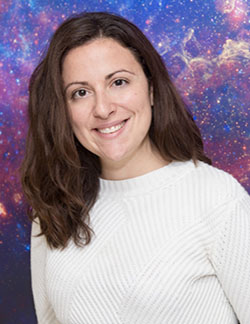
Department
School
Expertise
Biography
Dr. Gioia Rau joined Catholic University of America in November 2017, working at Goddard Space Flight Center in the Exoplanets and Stellar Astrophysics lab.
Dr. Rau studies the atmospheres of cool, giant stars, focusing on their chromospheric and atmospheric activity. She does so combining high-spectral resolution space-based Hubble Space Telescope data, with high-angular resolution ground-based interferometric data from observatories such as CHARA, ESO’s VLTI, and ALMA. She has been awarded several observing proposals as PI and Co-I.
Before that, in 2017 she was a visiting research scientist at ESO/Garching (Germany), after completing her PhD in Vienna (Austria, 2012-2016) on the study of Atmospheres of carbon-rich Asymptotic Giant Branch (AGB) stars, which received the prestigious fellowship grant "Abschlussstipendium, Universität Wien".
She received her Master degree with honors (cum laude) at La Sapienza University in 2011. In the final year of her Master she was awarded, for being 1 of the 4 students among the whole Science faculty (including Physics, Mathematics, Chemistry, Biology) having the highest-grade point average, the prestigious “Master Thesis' fellowship abroad”. Thanks to this she developed her Master Thesis at NASA/JPL-CalTech.
Link to CV: https://www.gioiarau.com/cv
Link to publications: https://www.gioiarau.com/publications
Research Interests
Research interests include: Atmospheres and chromospheres of cool, evolved stars (AGB stars, K-M giants and supergiants), Stellar evolution, Mass loss & stellar parameters, Cosmic dust, Circumstellar environments, High-angular resolution optical interferometry, Radio/sub-mm interferometry, Exoplanets. Previous: Cosmology, CMB.
Current Projects
Studying the chromospheric emission of red giant and red supergiant stars with the CHARAinterferometer.
• HST observations of cool evolved stars, modeling their chromospheric emission to understand their mass
loss.
• Investigating the origin of the molecular and dust environment in the atmospheres of AGB stars with the
ESO's VLT interferometer, and consequently their mass loss.
• Properties of Eta Carinae with ALMA.
• TESS, K2 and other NASA missions’ observations of cool, evolved stars.
